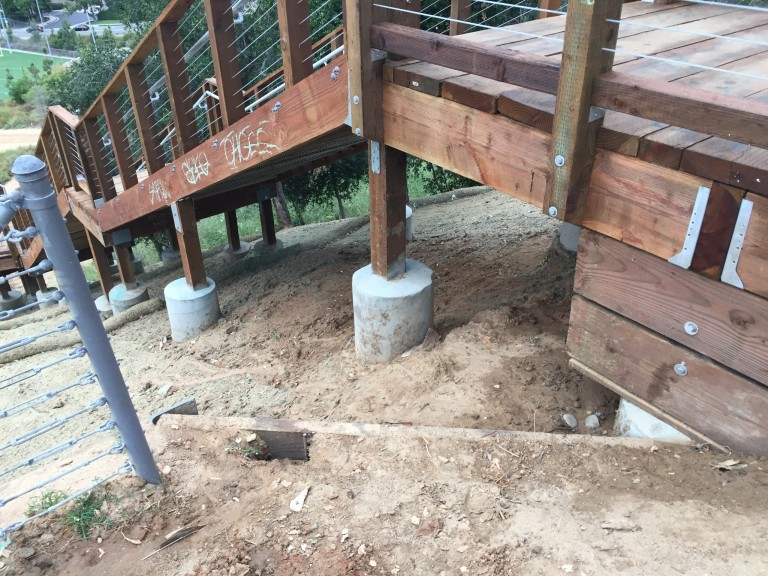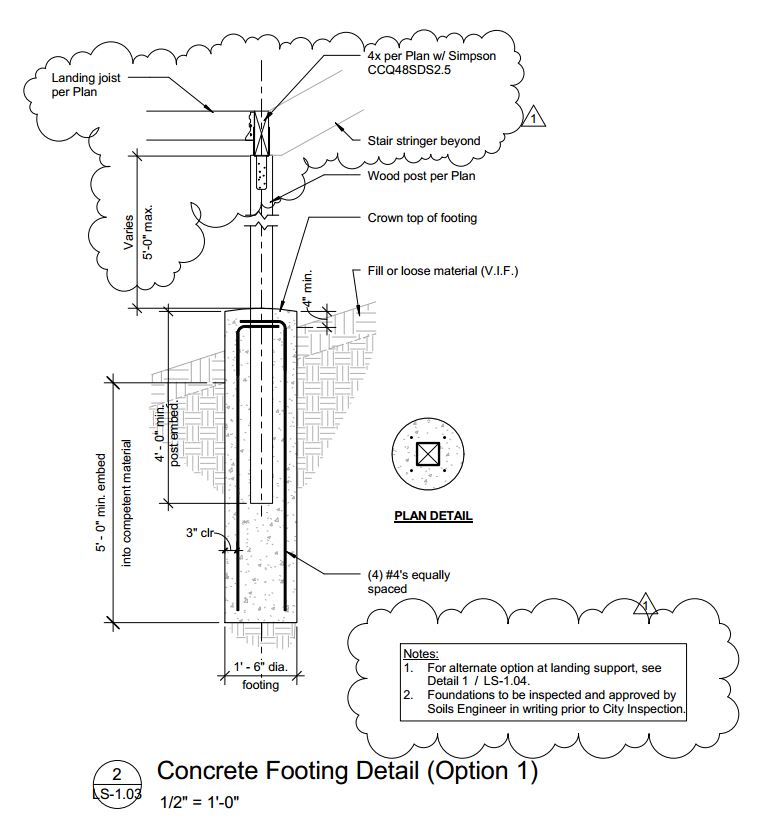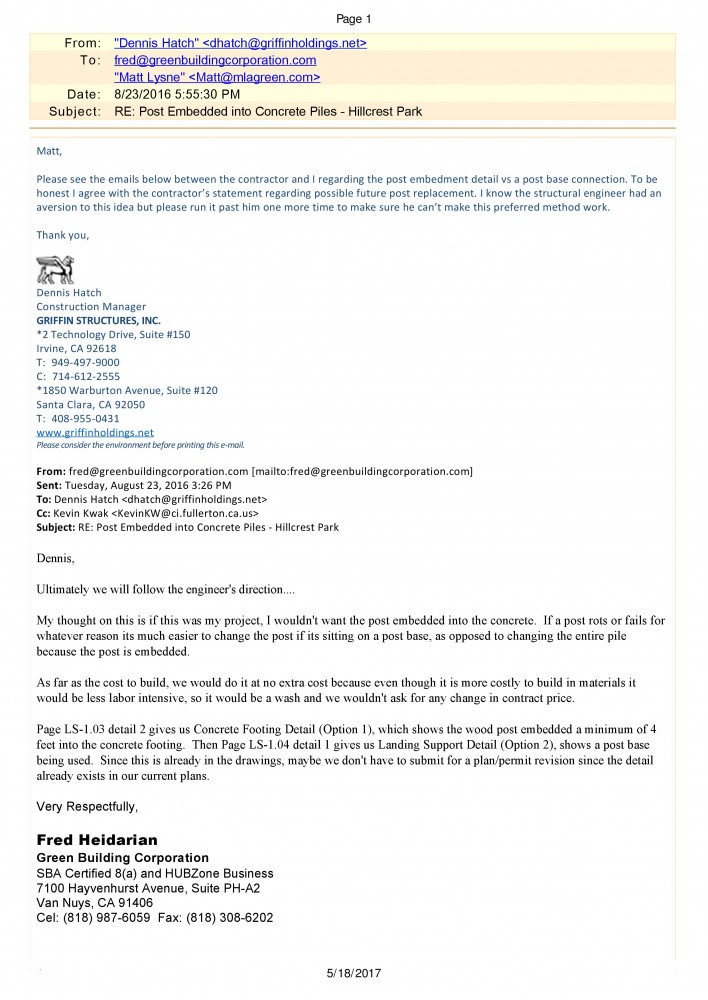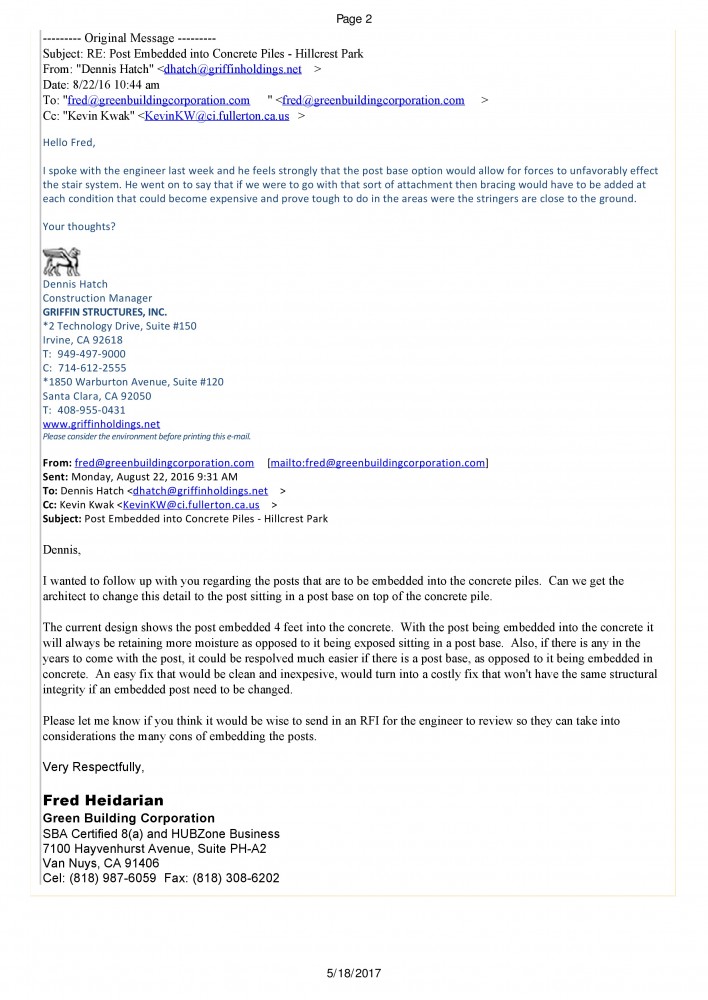Who Was in Charge?
During our series on the ill-fated, $1.6 million dollar “exercise stairs” in Hillcrest Park, some of our Friends correctly noted the problem of the wood support posts that had been poured into the concrete caissons that hold the whole structure up. Obviously, something went wrong. Notice how none of the posts are centered on the caissons, and some are barely two inches from the outside of the concrete, leading me to wonder how they managed to fit a rebar reinforcement inside the caisson.

From the project drawings, here is how the caisson and post are supposed to be aligned. The post centers on the caisson with 4 rebars equally spaced around it. Please notice the 3″ minimum clearance from the rebar to the outside of the concrete.

Clearly the footings and posts were built incorrectly. Obviously the caissons holes were drilled in the wrong places – and the construction manager must have agreed to let this pass. I guess we’ll just have to wait to see what happens. If the footings crack them may have to be replaced – and they weren’t built to be replaced.
This whole mess made me wonder about why the posts were sunk into the concrete in the first place – a very odd situation given that the expansion and contraction of the posts, when wet, could lead to potential concrete cracking and spalling, especially when the post is near the outer rim of the caisson.
It turns out I wasn’t alone. Here is a string of e-mails from the contractor, construction manager, and the architect discussing the redesign of the caissons and posts to a hardware connection – a solution that would make the replacement of the posts significantly easier. The contractor was willing to do this and add the necessary cross bracing at no cost to the City.
Request denied.
I wonder what will happen when the concrete caissons crack, or when the posts rot out. The architect seems to think the posts will outlast the rest of the rickety framing. I wonder which will go first.


From start to finish a fustercluck. Not needed, not well-designed, not well-built.
Thanks to the contractor for trying to do it right. No thanks to the contractor for putting the concrete in the wrong place.
From the tone of the emails, it sounds like these guys had figured out that the whole contraption was destined to be a throw-away. They’ve also given up on trying to save whatever is left of their professional reputations.
Yeah, it would be fun to hear what they DIDN’T put in writing!
I heard they put up a bunch of caution tape in the big gap between the safety railing and the top of the stairs. Looks real nice.
If those wood posts go 4 feet into the concrete and they’re not centered, where did the steel go?
Bad news: It was poorly built and won’t last 7-10 years.
Good news: Large construction contract now taking bids for construction to commence in 2027!
Everybody wins!
(how much union money was run through this project… worth looking into)
It’s engineering, construction work and city planning and inspectors. But somehow the problem is “unions”. Sure. Sounds like you’re injecting your politics.
Well, I suppose the 4 bars could still be placed 3″ from the edge – but they won’t center on the post – and the post is way too close to the outer edge with no rebar to re-inforce the concrete.
That’s correct. But the post is supposed to center on the 4 equally placed bar.
Maybe somebody from Griffin will stop by and explain why the caisson holes weren’t drilled in the right place and/or why they let that pass.
Not if the post is only 2″ from the edge of the pile.
The builder and the construction manager agreed that this sucks. Who told them not to fix it?
What is the treatment spec on the embedded wood posts? ACQ 60?
PRESSURE TREATMENT PROCESS SHALL BE APPROVED BY BUILDING
DEPARTMENT AND IDG. TREATMENT PROCESSES EFFECTING MATERIAL
PROPERTIES SHALL NOT BE USED ON STRUCTURAL LUMBER WITHOUT
IDG’S WRITTEN APPROVAL. ADDITIONALLY CUT ENDS OF LUMBERS MUST
BE FIELD TREATED WITH AN APPROPRIATE AGENT TO AVOID
COMPROMISING DECAY RESISTENCE OF LUMBER.
As an architect, I see this as a pretty thought out conversation between two of the players. Both understand and state the issues well. I’m not sure why this solution would have been rejected and don’t see the actual rejection in the chain of emails. Kudos to these two for raising the issue…too bad no one listened.
Well really it’s just common sense. Many engineers refuse to admit error – and that’s what this was. The City, however, could have insisted, but no one did.
The Architect ran this by Hugo, and Hugo said it was okay.